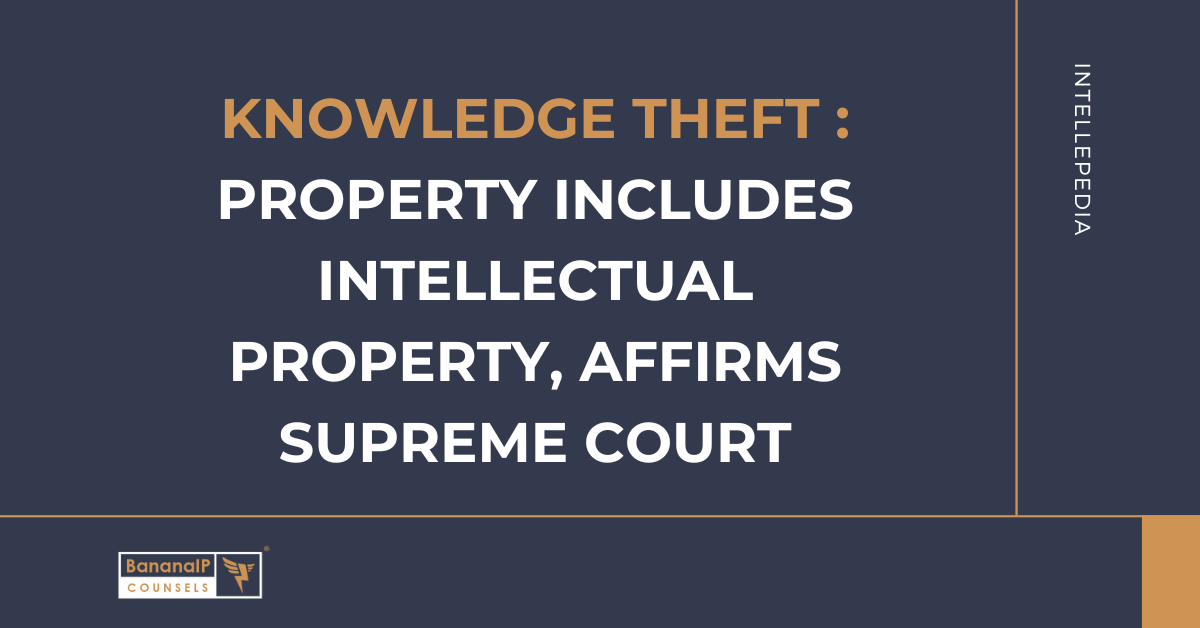Introduction
In a recent decision, the Supreme Court of India, affirmed a notable interpretation of the term “property” under the Scheduled Castes and Scheduled Tribes (Prevention of Atrocities) Act, 1989 (“Act”) made by the Bombay High Court.
The High Court held that intellectual property falls within the scope of “property” under Section 15A(11)(d) of the Atrocities Act. This section lists the rights of victims and witnesses as defined under the Act. Section 15A(11)(d) states:
“15A. Rights of victims and witnesses.—
… (11) It shall be the duty of the concerned State to specify an appropriate scheme to ensure implementation of the following rights and entitlements of victims and witnesses in accessing justice so as––
… (d) to provide relief in respect of death or injury or damage to property; …”
Later, a Special Leave Petition (SLP) was filed against the High Court’s order, which allowed the victim to claim loss of intellectual property, specifically research data, as damage due to a caste-based atrocity. The Supreme Court rejected the SLP for being devoid of merit and upheld the lower court’s reasoning.
Facts
Dr. Kshipra Kamlesh Uke and Dr. Shiv Shankar Das (jointly “Petitioners”), belonging to Scheduled Castes, hold Ph.D.s from Jawaharlal University, New Delhi, with specialisation in International Politics and Political Science, respectively. They were conducting a socio-political research project in Nagpur. Their research spanned several years and involved collection of significant data, including over 500 survey samples.
Their residence was allegedly broken into, in their absence, and their raw research data, including laptops and survey records, were stolen. They contended that the incident was a targeted caste-based atrocity, facilitated by the local police in collusion with a person from an upper caste.
They first approached the National Commission for Scheduled Castes (NCSC), which recommended a Special Investigative Team (SIT) probe, and compensation under the Atrocities Act. Although the Petitioners received some compensation, they were not compensated for the loss of research data and digital records. The authorities contended that intellectual property loss was intangible and did not fall within the purview of compensation under the Act.
Aggrieved by the same, the Petitioners filed a petition before the Bombay High Court seeking a writ of mandamus to enforce the NCSC’s recommendations, including compensation for the loss of their intellectual property.
Bombay High Court’s Interpretation
The main question before the Bombay High Court was whether the term “property” in Section 15A(11)(d) of the Act includes intellectual property such as research data and digital records.
The High Court made the following observations:
1. Property includes Tangible and Intangible Assets
The Court relied on definitions, jurisprudence and the Indian Penal Code, and concluded that “property” is not restricted to physical objects. It noted that intellectual property rights, including patents, copyrights, and research data, constitute property rights and, hence, should be protected under the Atrocities Act.
2. Compensation Must be Granted for Loss of Intellectual Property
The Court found that Rules 12(4) and (5) of the Scheduled Castes and Scheduled Tribes (Prevention of Atrocities) Rules, 1995, explicitly provide for compensation in case of damage to property. Since the Petitioners had suffered the loss of valuable research data due to an atrocity, they were entitled to adequate relief.
Bombay High Court’s Decision
The High Court directed the District Magistrate to evaluate the Petitioners’ claims and determine compensation for their loss of intellectual property. This interpretation gave judicial recognition to intellectual property within the ambit of atrocity-related compensation. It placed intellectual contributions such as research work on par with physical property.
Supreme Court’s Dismissal of the SLP
The Maharashtra Government challenged the Bombay High Court’s decision before the Supreme Court via SLP (Criminal) Diary No. 49832/2024. However, the Supreme Court, on 24th January 2025, dismissed the petition, stating:
“We do not find any merit in the Special Leave Petition. Hence, the Special Leave Petition is dismissed.”
By rejecting the SLP, the Supreme Court effectively upheld the Bombay High Court’s interpretation of “property”, confirming that the term includes intellectual property as well.
Conclusion
The Bombay High Court’s ruling, backed by the Supreme Court’s dismissal of the SLP, set a precedent for future cases involving loss or damage to intangible assets and expanded the scope of the term property to include intellectual property. The Courts merged intellectual property rights with social justice jurisprudence by recognising that knowledge, research, and digital data are integral to a person’s wealth and dignity.
However, determining the value of stolen research data will still be a challenge. It will be interesting to see how the authorities will assess the true value of such losses.
Relevant Paragraphs
“11. … The word “property” is not defined in any provision of the Atrocities Act and, therefore, must be given a plain and literal meaning to the word, which would include immovable and movable property, whether tangible or intangible or in any form of whatsoever nature which is capable of being valued. The meaning to be assigned to the word ‘property’ would include incorporeal property such as a right in rem, a right over material or immaterial things, and includes a legal right in a property not having any physical existence such as a Patent, a Copyright, or a Design which are intangible in nature and lack physical existence. Intellectual rights are rights in property even though they lack physical existence and are, therefore, capable of valuation for the purpose of deciding compensation or relief under the provisions of the Atrocities Act.”
“18. John Salmond in “Jurisprudence” defines “property” to mean:
“”In its widest sense, property includes all a person’s legal rights, of whatever description. A man’s property is all that is his in law. This usage, however, is obsolete at the present day, though it is common enough in the older books….In a second and narrower sense, property includes not all a person’s rights, but only his proprietary as opposed to his personal rights. The former constitute his estate or property, while the latter constitute his status or personal condition. In this sense a man’s land, chattels, shares, and the debts due to him are his property; but not his life or liberty or reputation. …In a third application, which is that adopted [here], the term includes not even all proprietary rights, but only those which are both proprietary and in rem. The law of property is the law of proprietary rights in rem, the law of proprietary rights in personam being distinguished from it as the law of obligations. According to this usage a freehold or leasehold estate in land, or a patent or copyright, is property; but a debt or the benefit of a contract is not…. Finally, in the narrowest use of the term, it includes nothing more than corporeal property — that is to say, the right of ownership in a material object, or that object itself.”
- Chapter XVII of the Indian Penal Code provides for offences against property. Under the Indian Penal Code “movable property” is defined in Section 22 to include corporeal property of every description, except land and thing attached to the earth or permanently fastened to anything which is attached to the earth. Thus, the definition of movable property includes all property other than immovable property which would include data, intellectual property and property of any description which is not fastened to the earth.
Considering the meaning of the word “property” from any angle, we are of the firm opinion that for the purpose of giving a meaningful interpretation to the word in Section 15A of the Act and in Rule 12 of the Atrocities Rules, the provisions do not admit of any exclusion to forms of property and would, thus, have to be given a wide and purposeful meaning. We, therefore hold that the intellectual property contained in the form of data or electronic material or any other material contained in the soft copy or digital form that may have been subject matter of the offence/crime and atrocities committed against the Petitioners, as claimed by them in their Ten Point claim and details of damaged items would be capable of valuation for the purpose of granting reliefs in terms of the provisions of Section 15A read with Rule 12 of the Atrocities Act and Rules made thereunder.
- Having held that the provisions of the Act would entitle the Petitioners to make a claim for relief for loss of their intellectual property as aforesaid, the question would be as to what relief the Petitioners would be entitled to.”
Citation
- Kshipra Kamlesh Uke & Anr. vs The Principal Secretary, Government of Maharashtra & Ors., Bombay High Court, on 10th November, 2023, accessible at: https://indiankanoon.org/doc/13000682/
- The Principal Secretary, Government of Maharashtra vs Kshipra Kamlesh Uke & Ors., Supreme Court of India, on 24th January, 2025, accessible at: https://indiankanoon.org/doc/101104269/
Authored by Kavya Sadashivan, IP Innovation, Consulting & Strategy Team, BananaIP Counsels.
Disclaimer
The case note/s in this blog post have been written by IP Attorneys at BananaIP Counsels based on their review and understanding of the Judgments. It may be noted that other IP attorneys and experts in the field may have different opinions about the cases or arrive at different conclusions therefrom. It is advisable to read the Judgments before making any decisions based on the case notes.
If you have any questions, or if you wish to speak with an IP expert/attorney, please reach us at: contact@bananaip.com or 91-80-26860414/24/34.



